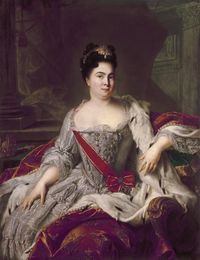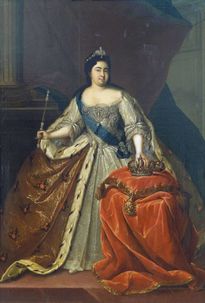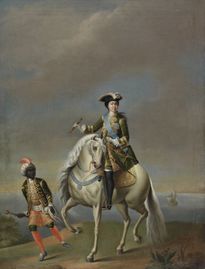يكاترينا الأولى من روسيا
| يكاترينا الأولى | |||||
|---|---|---|---|---|---|
 | |||||
| الامبراطورة وأتوقراط جميع الروس | |||||
| العهد | 8 فبراير 1725 – 17 مايو 1727 | ||||
| التتويج | 7 مايو 1724 (تُوجت كشريكة في الحكم) | ||||
| سبقه | پطرس الأول | ||||
| تبعه | پطرس الثاني | ||||
| الامبراطورة الحاكمة لجميع الروس | |||||
| الحكم | 22 أكتوبر 1721 – 8 فبراير 1725 | ||||
| وُلِد | 15 أبريل 1684[1] | ||||
| توفي | 17 مايو 1727 (aged 43) سانت پطرسبورگ، الامبراطورية الروسية | ||||
| الدفن | |||||
| الزوج | پطرس الأول | ||||
| الأنجال آخرون ... | آنا، دوقة شولسويگ-هولشتاين-گوتورپ إليزابث، امبراطورة روسيا | ||||
| |||||
| البيت | بيت رومانوڤ | ||||
| الأب | صمويل سكورونسكي | ||||
| الأم | إليزابث موريتز | ||||
| الديانة | اللوثرية، ثم الأرثوذكسية الشرقية | ||||
يكاترينا الأولى (روسية: Екатери́на I Алексе́евна, النطق Yekaterina I Alekseyevna; النطق الروسي: [jɪkətʲɪˈrʲinə ˈpʲɛrvəjə ɐlʲɪˈksʲejɪvnə], born پولندية: Marta Helena Skowrońska [ˈmarta xɛˈlɛna skɔˈvrɔɲska], باللاتڤية: [Marta Elena Skavronska] Error: {{Lang}}: text has italic markup (help)، لااحقاً مارفا صمويلوڤنا سكاڤرونسكايا؛ 15 أبريل [ن.ق. 5 أبريل] 1684 – 17 مايو [ن.ق. 6 مايو] 1727)، هي ثاني زوجات پطرس الأول، حكمت كامبراطورة لروسيا من 1725 حتى وفاتها.
رغم أنها في الأصل فلاحة لتوانية إلا أنها أعدت خطة ماكرة لجذب انتباه الإمبراطور بيتر الأول، حيث أوقعت نفسها في الأسر عندما غزت الجيوش الروسية بلادها حين كانت بعمر 18 سنة، وتمكنت لاحقا من الزواج من پطرس سنة 1712 ورزقا بإليزابيث روسيا وكانت أول مولودة لهما من ثم خلفت زوجها في حكم البلاد حتى توفيت ليخلفها حفيدها القيصر پطرس الثاني. قامت الكنيسة الأرثوذكسية بعد توليها الحكم بتغيير اسماها إلى كاترينا أليكسييڤنا.
. . . . . . . . . . . . . . . . . . . . . . . . . . . . . . . . . . . . . . . . . . . . . . . . . . . . . . . . . . . . . . . . . . . . . . . . . . . . . . . . . . . . . . . . . . . . . . . . . . . . . . . . . . . . . . . . . . . . . . . . . . . . . . . . . . . . . . . . . . . . . . . . . . . . . . . . . . . . . . . . . . . . . . . .
حياتها كخادمة
The life of Catherine I was said by Voltaire to be nearly as extraordinary as that of Peter the Great himself. Only uncertain and contradictory information is available about her early life. Said to have been born on 15 April 1684 (o.s. 5 April),[1] she was originally named Marta Helena Skowrońska. Marta was the daughter of Samuel Skowroński (later spelt Samuil Skavronsky), a Roman Catholic farmer from the eastern parts of the Polish–Lithuanian Commonwealth, born to Minsker parents. In 1680 he married Dorothea Hahn at Jakobstadt. Her mother is named in at least one source as Elizabeth Moritz, the daughter of a Baltic German woman and there is debate as to whether Moritz's father was a Swedish officer. It is likely that two stories were conflated, and Swedish sources suggest that the Elizabeth Moritz story is probably incorrect. Some biographies state that Marta's father was a gravedigger and handyman, while others speculate that he was a runaway landless serf.
Marta's parents died of the plague around 1689, leaving five children. According to one of the popular versions, at the age of three Marta was taken by an aunt and sent to Marienburg (the present-day Alūksne in Latvia, near the border with Estonia and Russia) where she was raised by Johann Ernst Glück, a Lutheran pastor and educator who was the first to translate the Bible into Latvian.[2] In his household she served as a lowly servant, likely either a scullery maid or washerwoman.[3] No effort was made to teach her to read and write and she remained illiterate throughout her life.
Marta was considered a very beautiful young girl, and there are accounts that Frau Glück became fearful that she would become involved with her son. At the age of seventeen, she was married off to a Swedish dragoon, Johan Cruse or Johann Rabbe, with whom she remained for eight days in 1702, at which point the Swedish troops were withdrawn from Marienburg. When Russian forces captured the town, Pastor Glück offered to work as a translator, and Field Marshal Boris Sheremetev agreed to his proposal and took him to Moscow.
There are unsubstantiated stories that Marta worked briefly in the laundry of the victorious regiment, and also that she was presented in her undergarments to Brigadier General Rudolph Felix Bauer, later the Governor of Estonia, to be his mistress. She may have worked in the household of his superior, Sheremetev. It is not known whether she was his mistress, or household maid.[بحاجة لمصدر] She travelled back to the Russian court with Sheremetev's army.[3]
Afterwards she became part of the household of Prince Alexander Menshikov, who was the best friend of Peter the Great of Russia. Anecdotal sources suggest that she was purchased by him. Whether the two of them were lovers is disputed, as Menshikov was already engaged to Darya Arsenyeva, his future wife. It is clear that Menshikov and Marta formed a lifetime alliance.
It is possible that Menshikov, who was quite jealous of Peter's attentions and knew his tastes, wanted to procure a mistress on whom he could rely. In any case, in 1703, while visiting Menshikov at his home, Peter met Marta.[بحاجة لمصدر] In 1704, she was well established in the Tsar's household as his mistress, and gave birth to a son, Peter.[4] In 1703,[5] she converted to Orthodoxy and took the new name of Catherine Alexeyevna (Yekaterina Alexeyevna).[3] She and Darya Menshikova accompanied Peter and Menshikov on their military excursions.
الزواج والحياة العائلية
Though no record exists, Catherine and Peter are described as having married secretly between 23 October and 1 December 1707 in Saint Petersburg.[6] They had twelve children, two of whom survived into adulthood, Anna (born 1708) and Elizabeth (born 1709).
Peter had moved the capital to St. Petersburg in 1703. While the city was being built he lived in a three-room log cabin with Catherine, where she did the cooking and caring for the children, and he tended a garden as though they were an ordinary couple.[بحاجة لمصدر] The relationship was the most successful of Peter's life and a great number of letters exist demonstrating the strong affection between Catherine and Peter.[6] As a person she was very energetic, compassionate, charming, and always cheerful. She was able to calm Peter in his frequent rages and often was called in to do so. Catherine went with Peter on his Pruth Campaign in 1711. There, she was said to have saved Peter and his Empire, as related by Voltaire in his book Peter the Great. Surrounded by overwhelming numbers of Turkish troops, Catherine suggested before surrendering, that her jewels and those of the other women be used in an effort to bribe the Ottoman grand vizier Baltacı Mehmet Pasha into allowing a retreat.
Mehmet allowed the retreat, whether motivated by the bribe or considerations of trade and diplomacy. In any case Peter credited Catherine and proceeded to marry her again (this time officially) at Saint Isaac's Cathedral in St. Petersburg on 9 February 1712. She was Peter's second wife; he had previously married and divorced Eudoxia Lopukhina, who had borne him the Tsarevich Alexis Petrovich. Upon their wedding, Catherine took the style of her husband and became Tsarina. When Peter elevated the Russian Tsardom to Empire, Catherine became Empress. The Order of Saint Catherine was instituted by her husband on the occasion of their wedding.
الأنجال
أنجبت يكاترينا من پطرس اثنى عشر طفلا، توفوا جميعهم في طفولتهم عدا آنا وإليزابث:
- پيوتر پتروڤيتش و. 1704 توفا رضيعاً [4]
- پاڤل پتروڤيتش و. 1705، توفى رضيعاً[4]
- كاثرين پتروڤنا و. ديسمبر 1706–يونيو 1708[4]
- الدوقة العظمى آنا پتروڤنا 1708–1728
- الدوقة العظمى إليزابث پتروڤنا 1709–1762
- الدوقة العظمى ماريا پتروڤنا 1713–1715
- الدوقة العظمى مارگريتا پتروڤنا 1714–1715
- الدوق الأعظم پيوتر پتروڤيتش 1715–1719
- الدوق الأعظم پاڤل پتروڤيتش 1717–1717
- الدوقة العظمى نتاليا پتروڤنا 1718–1725
- الدوق الأعظم پيوتر پتروڤيتش (1723–1723)
- پاڤل پتروڤيتش 1724–1724
الأشقاء
Upon Peter's death, Catherine found her four siblings, Krystyna, Anna, Karol, and Fryderyk, gave them the newly created titles of Count and Countess, and brought them to Russia.
- Krystyna Skowrońska, renamed[بحاجة لمصدر] Christina (روسية: Христина) Samuilovna Skavronskaya (1687–14 April 1729), had married Simon Heinrich (روسية: Симон Гейнрих) (1672–1728) and their descendants became the Counts Gendrikov.
- Anna Skowrońska, renamed Anna Samuilovna Skavronskaya, had married one Michael-Joachim N and their descendants became the Counts Efimovsky.
- Karol Skowroński, renamed Karel Samuilovich Skavronsky, was created a Count of the Russian Empire on 5 January 1727[4] and made a Chamberlain of the Imperial Court; he had married Maria Ivanovna, a Russian woman, by whom he had descendants who became extinct in the male line withe the death of Count Paul Martinovich Skavronskyi (1757-1793), father of Princess Catherine Bagration.
- Fryderyk Skowroński, renamed Feodor Samuilovich Skavronsky, was created a Count of the Russian Empire on 5 January 1727[4] and was married twice: to N, a Lithuanian woman, and to Ekaterina Rodionovna Saburova, without having children by either of them.[7]
تولي العرش
Catherine was crowned in 1724. The year before his death, Peter and Catherine had an estrangement over her support of Willem Mons, brother of Peter's former mistress Anna, and brother to one of the current ladies in waiting to Catherine, Matryona Balk. He served as secretary to Catherine. Peter had fought his entire life to clear up corruption in Russia. Catherine had a great deal of influence on who could gain access to her husband. Willem Mons and his sister Matrena had begun selling their influence to those who wanted access to Catherine and, through her, to Peter. Apparently this had been overlooked by Catherine, who was fond of both. Peter found out and had Willem Mons executed and his sister Matrena exiled. He and Catherine did not speak for several months. Rumors flew that she and Mons had had an affair, but there is no evidence for this.
Peter died (28 January 1725 Old Style) without naming a successor. Catherine represented the interests of the "new men", commoners who had been brought to positions of great power by Peter based on competence. A change of government was likely to favor the entrenched aristocrats. For that reason during a meeting of a council to decide on a successor, a coup was arranged by Menshikov and others in which the guards regiments with whom Catherine was very popular proclaimed her the ruler of Russia. Supporting evidence was "produced" from Peter's secretary Makarov and the Bishop of Pskov, both "new men" with motivation to see Catherine take over. The real power, however, lay with Menshikov, Peter Tolstoy, and with other members of the Supreme Privy Council.
Catherine viewed the deposed empress Eudoxia as a threat, so she secretly moved her to Shlisselburg Fortress near St Petersburg to be put in a secret prison under strict custody as a state prisoner.
التقدير
وفاتها
توفت بعد سنتين من وفاة پطرس، في الثالثة والأربعين من عمرها، في سانت پطرسبورگ، حيث دُفنت في حصن القديس پطرس وپولس. مرض السل، تم تشخيصه على أنه خراج بالرئة، مما تسبب في وفاتها المبكرة.
انظر أيضاً
الهوامش
- ^ أ ب Encyclopedia Britannica
- ^ "National treasure: The first Bible in Latvian". eng.lsm.lv (in الإنجليزية). Retrieved 2020-09-15.
- ^ أ ب ت Hughes 2004, p. 131.
- ^ أ ب ت ث ج ح Hughes 2004, p. 135.
- ^ "Catherine I empress of Russia". Britannica. Encyclopædia Britannica. Retrieved 28 January 2022.
- ^ أ ب Hughes 2004, p. 136.
- ^ Skavronsky
المصادر
- Hughes, Lindsey (2004). "Catherine I of Russia, Consort to Peter the Great". In Campbell Orr, Clarissa (ed.). Queenship in Europe 1660-1815: The Role of the Consort. Cambridge University Press. pp. 131–154. ISBN 0-521-81422-7.
- Lincoln, W. Bruce (1981). The Romanovs. New York: Dial Press.
- Massie, Robert K (1980). Peter the Great. New Jersey: Random House.
- History of the Russian Empire Under Peter the Great (Vol. I 1759; Vol. II 1763).
- Five Empresses: Court Life in Eighteenth-Century Russia Praeger Publishers; Connecticut, 2004
- Royal Babylon: The Alarming History of European Royalty Broadway; New York, 2001
 Chisholm, Hugh, ed. (1911). . دائرة المعارف البريطانية (eleventh ed.). Cambridge University Press.
Chisholm, Hugh, ed. (1911). . دائرة المعارف البريطانية (eleventh ed.). Cambridge University Press. {{cite encyclopedia}}: Cite has empty unknown parameter:|coauthors=(help)
. . . . . . . . . . . . . . . . . . . . . . . . . . . . . . . . . . . . . . . . . . . . . . . . . . . . . . . . . . . . . . . . . . . . . . . . . . . . . . . . . . . . . . . . . . . . . . . . . . . . . . . . . . . . . . . . . . . . . . . . . . . . . . . . . . . . . . . . . . . . . . . . . . . . . . . . . . . . . . . . . . . . . . . .
وصلات خارجية
 "Catharine I.". New International Encyclopedia. 1905.
"Catharine I.". New International Encyclopedia. 1905.- Romanovs. The third film. Peter I, Catherine I at YouTube – Historical reconstruction "The Romanovs". StarMedia. Babich-Design(Russia, 2013)
| ألقاب ملكية | ||
|---|---|---|
| سبقه پطرس الأول |
امبراطورة روسيا 1725–1727 |
تبعه پطرس الثاني |
| الملكية الروسية | ||
| سبقه أودوكسيا لوپوخينا |
القيصرة الحاكمة لروسيا 1712–1725 |
تبعه صوفيا أنهالت-زربست |
- Short description is different from Wikidata
- Lang and lang-xx template errors
- Articles containing روسية-language text
- Articles containing پولندية-language text
- Articles with unsourced statements from March 2015
- Articles with unsourced statements from October 2015
- مقالات المعرفة المحتوية على معلومات من دائرة المعارف البريطانية طبعة 1911
- مواليد 1684
- وفيات 1727
- امبراطورات روسيات
- امبراطورات حاكمات
- بيت رومانوڤ
- Converts to Eastern Orthodoxy from Lutheranism
- Converts to Lutheranism from Roman Catholicism
- ملوك أرثوذكس
- روس من أصل لتواني
- مدفونون في كاتدرائية پطرس وپولس
- نساء من القرن 17
- إستونيو القرن 17
- روس القرن 17
- لاتڤيو القرن 17
- حاكمات من القرن 18
- إستونيو القرن 18
- لاتڤيو القرن 18
- روس القرن 18
- حائزو وسام القديس أندرو
- ملوك القرن 18 في أوروپا





